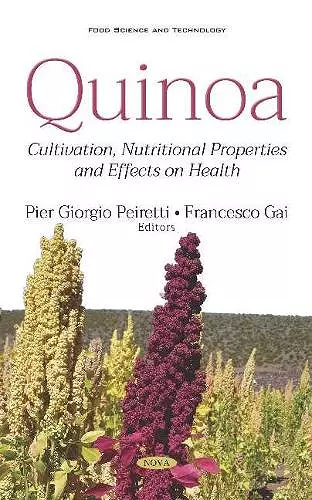Quinoa
Cultivation, Nutritional Properties and Effects on Health
Francesco Gai editor Pier Giorgio Peiretti editor
Format:Hardback
Publisher:Nova Science Publishers Inc
Published:17th May '19
Currently unavailable, and unfortunately no date known when it will be back

Quinoa (Chenopodium quinoa Willd) is a pseudocereal of Andean origin that is becoming more and more popular in Europe, Asia and the United States of America because it is a good source of different nutrients, rich in antioxidant compounds and it offers an alternative to classical cereals in celiac diet because its seeds are gluten-free. Concerning its employment in food application, quinoa-derived products have been successfully employed in the preparation of different foods as fat/cream substitutes and to enhance the quality of baked foods. This book aims to review recent advances in the quinoa plant cultivation as well as the nutritional properties and effects on human health of quinoa-derived products. Chapter One focuses on the morphophenological evaluation of different quinoa accessions collected all over the world and their agronomical performances tested both in the experimental field and open field trials. In Chapter Two, the authors provide a description of the phenology, made on three different growing seasons, of a wide group of quinoa varieties, collected in different environments, in field conditions at the Peruvian central coast. Chapter Three evaluates the antioxidative capacity and phenolic compounds content in the aerial part of the quinoa plant during its growth cycle in six progressive morphological stages from the early vegetative to the grain fill stage. In Chapter Four, the authors determined the nutritional value and content of some bioactive compounds in different quinoa (Chenopodium quinoa Willd.), kañiwa (Chenopodium pallidicaule Aellen) and kiwicha (Amaranthus caudatus L.) ecotypes collected in Peru. Chapter Five describes the potential use of quinoa seed and plant in animal nutrition. The authors of Chapter Six described the employment of the fermentation process to improve technological, nutritional and sensory quality of quinoa in order to obtain the fortification of conventional or novel foods. The aim of chapter seven is to review the available studies on the use of quinoa as a bread making ingredient. In Chapter Eight, the authors examined the quality characteristics of cereal-based foods enriched with quinoa flour and inulin with a different degree of polymerization in order to obtain new fortified breads and pasta with lowering glicemic index effect. Chapter Nine evaluates studies carried out to develop healthier gluten-free products, considering sensory and technological aspects of quality to help promoting the quality of...
ISBN: 9781536150612
Dimensions: unknown
Weight: 556g
328 pages